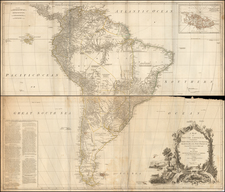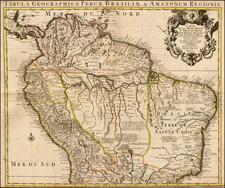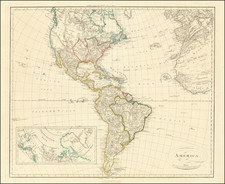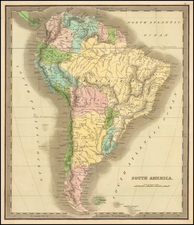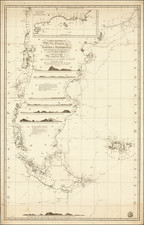Exceedingly rare plan of the harbor at Cartagena, Colombia, published during the War of Jenkins Ear, which may have been prepared in connection with a manuscript report written by Sebastián de Eslava, Viceroy of New Granada.
Engraved by a fine hand, this plan is unlike virtually all other plans, almost all of which are oriented with east at the top. Only the Ulloa plan of of Cartagena Bay has a similar orientation.
This finely executed plan was made on the occasion of the famed battle of Cartagena de Indias, between the British forces led by Vice Admiral Edward Vernon and Spanish colonial forces, led by Governor General Blas de Lezo, in 1741.
A part of the War of Jenkin's Ear, the British campaign against Cartagena was one of largest naval engagements of the modern era, and was also a great failure, with the losses sustained by the British forces quite catastrophic, devastating Britain's presence in the Caribbean.
The history of the battle is extremely interesting. The city of Cartagena was rich and prosperous, thus promoting England's interest in capturing the City. Admiral Veron led the force sent to take the city, with a combined fleet of 186 ships. Cartagena was under the command of Governor General Don Blas de Lezo, a man known as "Patapalo", a remarkable character who had lost an eye, a leg and an arm in the course of his career. He was an experienced military man, who had been involved in virtually all the major battles Spain had entered in his era.
Initially the overwhelming and significantly larger British fleet gained positions over the defending army. Vernon, confident on the imminent result sent news to his King of the victory. The King of England ordered the minting of celebratory medals to commemorate the taking of one of the most prominent cities in the Caribbean. The Spanish had only left to regroup, and their counter-attack successfully drove the British out of Cartagena.
The map is extremely rare. We have been unable to find another copy anywhere. The large cartouche gives a short, but comprehensive explanation of the events, forces participating and the outcome, providing as follows:
"El dia 14 de Marzo se pusieron delante d Bocachica con mas d 140. Velas con animo d ganar esta Fortaleza pra entrar asitiar la Plaza d Cartagena dsenbacaron 40 Yngs, y 500 Negros y acatando a Bocachica p Mar y tiera la tomaron el dia 25 de Marzo… saliendo el Virrey con 1500 hombres, de tropa reglada y 1800 Yndios y Negros los ataco y derroto a los restantes . . .
A letter key on the upper left marks important places, fortresses and buildings of the city; the sea is shown with sailing ships along the coastline -a few making port- and a compass rose. We note the existence of a document listed on page 93 of the Comisión de Antigüedades de la Real Academia de la Historia: Documentación General, Catálogo e índices, published by the Real Academia de la Historia, July 2002, which is described as:
Copia de un manuscrito del siglo XVIII titulado "Relacion del sitio de Cartagena. Año de 1741" de Sebastian de Eslava y Pedro Mur.
Given the similarity of the titles and the refverence to Sebastian de Eslava in the map, there is good reason to believe that the manuscript map may be drawn from a manuscript map made under his direction and intended to illustrate this manuscript relacion of the battles at Cartagena in 1741.
The importance of the failed expedition resulted in a considerable number or broadsides and relations being printed, this plan in particular seems to have been separately published. According to Medina, there was a printed house in Colombia, which began operation in 1738 and closed either in 1742 (per Medina) or 1745 (per Torre Revello). The chances of this being a Colombian impression are remote, however possible.









